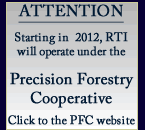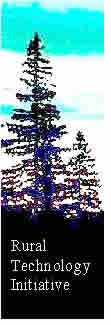 |
 |
 |
 |


Spring 2005, Volume 5, No. 2
Click here for a PDF copy of this Newsletter!Table of Content
|
|||||||||||||||||||||||||||||||||||||||||||||||||||||||
|
specific forest insect or disease risks and adjusting them for site quality measures. Development of a density threshold modeling approach for bark beetle epidemics and fire risk reduction by habitat type may also yield a methodology that can be used to establish interim thresholds for other forest insects and diseases. Initial efforts would concentrate on extending past studies on mountain pine beetle (Dendroctonus ponderosae) to plant associations with ponderosa pine, lodgepole pine, and Western white pine to establish an administratively feasible range of thresholds based on site similarities. Initial work will link thresholds to the plant association groups used by in the Forest Vegetation Simulator (FVS), a widely used forest growth model developed by the Forest Service and used with LMS. FVS has specialized versions that incorporate the risk and impacts of dwarf mistletoe, Douglas-fir beetle, Douglas-fir tussock moth, mountain pine beetle, western root disease, and western spruce budworm damage. Extension and refinement of these capabilities to incorporate site specific risk assessment procedures can be |
accomplished within the LMS framework through additional technological development. Non-market valuation will likely be of paramount importance in making decisions for forest health treatment options in today’s fiscal climate. Reducing fire and insect risks will avoid future costs, which can justify expensive treatments if proper accounting is done. LMS and its associated carbon accounting, fire risk, and economic assessment tools provide innovative ways of meeting the multiple demands on public resources in a fiscally responsible manner. During development of the FHSWG report, the call for better information and better ways of analyzing information clearly points the way to the increased use of technology. As part of that effort, RTI hopes to continue its participation and technical support of the FHSWG and its efforts where they are consistent with our mandate and focus on providing decision support for rural landowners to make sound forest management decisions. - Elaine Oneil, RTI Research Assistant - |
Economic impacts of forest tax policies on small forest landowners: Two comparative case studiesForest taxation is an important issue that can have significant economic impacts on small forest landowners. Federal and state forest taxes are complicated, variable, and may serve to either encourage or discourage sustainable forest management. It is not always clear how different tax policies will impact landowners. To demonstrate some of these impacts, we offer two case study comparisons. The first case study is a comparison of forest property taxation between two states: Washington and Oregon. The second case study is a look at the changes in how reforestation expenses are treated for federal income taxes under the American Jobs Creation Act of 2004. Case Study 1: Forest property taxation in Oregon vs. Washington Oregon and Washington are states with similar forest conditions and management challenges. These states have very different approaches, though, when it comes to levying property taxes on land and timber. In Washington, timber and land are taxed separately. Timber is subject to the Forest Excise Tax (FET) at the time of harvest, which is 5% of the stumpage value or 4.2% if the Salmon Credit applies. Forestland is taxed on an annual “ad valorem” basis (which translated means “based on value”) similar to other types of land, homes, etc. Forestland appraised values are set by the Washington Department of Revenue (WADOR) based on land grade (site class) and operability class to reflect the value of the land for commercial forestry. Using a formula, these values are updated annually to reflect changes in stumpage value trends. These values are available from the WADOR at this link. In Oregon, timber is subject to the Forest Products Harvest Tax (FPHT), which is determined annually by the Oregon Legislature and the Oregon Forest Resources Institute. For 2005, the FPHT is $2.85 per thousand board feet (MBF) of harvested timber. A landowner’s first 25 thousand board feet (MBF) of harvested timber per year is exempt from this tax. Like Washington, forestland in Oregon is also taxed on an annual ad valorem basis, with land values determined by the Oregon Department of Revenue (ORDOR) based on land productivity class. These values are |
available from the ORDOR at this link. Small woodland owners in Oregon are eligible for an alternative tax option called the Small Tract Forestland (STF) Option. Under this program, landowners pay annual property taxes on only 20% of the assessed value of their forestland but are subject to an additional severance tax at the time of harvest. For 2004, this severance tax rate for western Oregon was $3.89/MBF. To see how these different tax programs compare, consider an acre of forestland that is site class II with high operability. The assessed land value in Washington would be approximately $170/acre. The equivalent land productivity class in Oregon would have an assessed value of $367.71/acre. This would be reduced to $73/acre (20%) assuming the landowner was enrolled in the STF Option. Assuming a tax rate of $15 per $1,000 of assessed value, the annual taxes for this acre of forestland would be $2.55 in Washington compared to $1.10 in Oregon. To compare taxes on harvested timber, consider 1 MBF of
Douglas-fir. According to the 2005 WADOR stumpage tables
for Region 4 (southern Puget Sound), the average stumpage
value for Douglas-fir is approximately $420/MBF. In Washington,
the 4.2% FET (assuming the salmon credit) would amount to
$17.64/MBF. In Oregon, the combined FPHT and severance tax
under the STF Option would be $2.85 + $3.89 = $6.74/MBF,
or 1.6% of the stumpage value. |
Table 1: Comparison of property tax impacts between Washington
and Oregon for an example Douglas-fir rotation
Case study 2: Changes in how reforestation costs are treated under the American Jobs Creation Act of 2004 The American Jobs Creation Act of 2004 included significant changes for federal taxes on timber income, such as a broader eligibility for capital gains treatment and an option for qualifying taxpayers to deduct reforestation costs sooner than had previously been the case. These changes have been advertised as advantageous for forest landowners. However, there is one drawback in that the 10% reforestation tax credit was eliminated. Under the previous tax rules, qualifying taxpayers could receive a 10% tax credit for up to $10,000 of reforestation costs. Qualifying taxpayers could then also amortize 95% of those costs over 7 years, deducting 1/14th of the costs in year 0 and year 7, while deducting 1/7th of the cost in years 1-6. Costs over $10,000 had to be capitalized to be ducted when the timber or property was sold. Under the new tax rules, qualifying taxpayers can deduct up to $10,000 of reforestation costs in the year that they occur. Any costs over $10,000 can now be amortized using the 7-year schedule. This is economically advantageous in that expenses both up to and over $10,000 can be deducted sooner and thus those deductions are worth more in terms of present value. However, the loss of the reforestation tax credit is significant, because a tax credit directly reduces the tax owed on a dollar for dollar basis, whereas a tax deduction reduces taxable income. In other words, assuming a tax rate of 28%, a $1,000 tax deduction would reduce taxes by $280, |
compared to reducing taxes by the full $1,000 if it were
a tax credit. Table 2: Comparison of income tax impacts between the old and new rules for an example Douglas-fir rotation.
To see what these differences mean in terms of SEV, we will use the example from above of a 50-year Douglas-fir rotation with a $100/acre PCT cost in year 15, $15/acre/year overhead costs, and $14,700/acre final harvest revenue in year 50, which we will assume is taxed at a capital gains rate of 15%. Under the old rules, the SEV for this regime is $718/acre. Under the new rules, the SEV is $703/acre; indicating a $15/acre loss in asset value. Thus for some landowners, especially those with less than $10,000 in annual reforestation expenses, these recent federal tax law changes will actually increase tax burdens, lowering economic returns. A summary of impacts between the old and new rules is shown below in Table 2. - Kevin Zobrist, RTI Staff - |
Streaming Videos From WSU ExtensionWith the help of RTI funding, and guidance from RTI and the University of Washington, WSU Extension has been putting up streaming videos on a number of topics to aid in Extension education and outreach. We have filmed and published single presentations as well as whole workshops and conferences. Most of these presentations have covered forestry topics, though we have also covered other Extension education events. By the end of 2004, we put 123 presentations online with 17 more in the works. Of the 123 presentations currently online 42 are video or video/PowerPoint presentations, 78 are audio/PowerPoint presentations, and 3 are PowerPoint only presentations. Topics range from managing for wildlife to fire regimes to human dimensions of forestry. The presentations are easy to |
view from the WSU Extension website, http://ext.nrs.wsu.edu/Video/index.htm, and most anyone with a computer and an internet connection can view these presentations at their leisure. The streaming video format allows viewers to pause, fast-forward, and rewind presentations. It is also possible to skip around in most presentations using the 'clickable' outline. We continue to experiment with some different editing and publishing programs as well as film and audio capturing techniques. We are still learning what does and does not work well, but ease of use and ready access online has made many Coached Planning presentations and multiple conferences available to a worldwide audience. - Owyhee Weikel-Magden, WSU Extension - |
RTI Introduces New GIS Training CourseRTI has introduced a new Geographic Information Systems (GIS) training course that covers the latest generation of ESRI’s GIS software: ArcGIS® 9. The first offering of this new training course was held in early March, 2005, at Washington State University’s Learning Center in Port Hadlock, WA. The course was taught by RTI GIS Specialist Luke Rogers, who is trained as an ESRI-authorized ArcGIS 9 instructor and has close to 10 years of GIS experience. There were 16 participants for this course, including forestry consultants, government officials, students, and educators. The 2-day course covered fundamental GIS concepts, including
how to query a GIS database, manipulate tabular data, edit
spatial and attribute data, and present data clearly and
efficiently using maps and charts. Participants learned how
to use ArcMap™, ArcCatalog™, and ArcToolbox™,
and they explored how these applications work together to
provide a complete GIS software solution. ArcGIS, which is
one of the world’s most widely used GIS software packages,
employs an easy to use “point-and-click” interface
that runs on a variety of different computer systems (e.g.
PC, Macintosh, UNIX, etc.). |
With the release of ArcGIS 9, ESRI has brought forward all of the functionality available in ArcView 3.x (previously used in RTI GIS trainings) into a new and powerful program that fully integrates with Microsoft Windows. With the availability of ArcGIS 9, many GIS users are switching from ArcView 3.x. Now is a great time for landowners, consultants, and educators to transition data and products from older generations of GIS software to ArcGIS 9. One participant commented that the course “helped [her] understand new concepts in ArcGIS 9…it is a good start to move from 3.2 to 9. Luke did a professional job in presenting the concepts of this course and has a vast amount of knowledge to share.” For those people still using ArcView 3.x, RTI has partnered
with a University of Washington GIS instructor to host a
full on-line course via the RTI website. People will be able
to log on to the site and access lectures, hands-on exercises,
and readings. The next ArcGIS course will be offered December
4-6 at the University of Washington’s Pack Forest in
Eatonville, Washington. Additional information is available
at http://www.ruraltech.org/training/. -By Ara Erickson and Luke Rogers, RTI Staff- |
RTI Offers Technology Segment for Coached Stewardship PlanningIn an effort to improve technology delivery to forest landowners, RTI is now offering a technology segment as part of the "Coached" Forest Stewardship Planning short courses that are offered throughout Washington. The Coached Planning short courses are intensive, eight-week courses offered by the Department of Natural Resources (DNR) and WSU Extension to help landowners establish management objectives for their property and then develop a management plan to meet those objectives. The new RTI segment introduces the Landscape Management System (LMS) and key companion programs like the Inventory Wizard as additional tools that landowners can use to develop and implement their management plans. Technology like LMS is very applicable to the stewardship planning process. LMS is a user-friendly program that is designed for a range of skill levels, and the Inventory Wizard companion program makes it quick and easy for landowners to get their forest data into the system. LMS offers landowners the opportunity to experiment with and explore the outcomes of different management choices while always having the option to put the trees "back on the stump" with a click of the mouse. Once a management plan is developed, LMS can support this plan by providing predictions of a variety of outcomes, including harvest volumes, cash flows, rates of return, stand structure, and habitat quality. LMS can further be used as a communication tool, providing visualizations and other outputs to help landowners exchange ideas |
with foresters, forestry contractors, family members, and others. Participants in the Coached Planning short courses learn the basics about what LMS is and how it can be used to both make and communicate forest management decisions. Participants are also introduced to the Inventory Wizard and are taught the basics of how to collect the necessary forest inventory data in the field. There are hands-on opportunities to practice these concepts during the field day portion of the program, as well as during one-on-one site visits with a DNR Stewardship Forester or wildlife biologist. By the end of the program, participants have everything they need to get started using LMS, including a copy of both LMS and the Inventory Wizard on CD-ROM. So far the new technology segment has been offered as part of the short courses held in Friday Harbor and Deming. This spring the segment will be included with the field day portion of the program, starting in May in Jefferson County. This will give participants the opportunity to see and practice the whole process from field data collection to computer simulations in one day. LMS and the Inventory Wizard will also be included in the "Measuring Your Forest Workshop" this July in Kitsap County, which is part of the Coached Planning 201 Summer Series, where inventory techniques will be covered in more depth. For more information about the WSU/DNR Coached Forest Stewardship Planning short courses, contact WSU Extension at 509-335-2963 or visit http://ext.nrs.wsu.edu/. - Kevin Zobrist, RTI Staff, and |
Upcoming Events |
 |
|
| June 13-15, 2005 GPS Training Workshop Pack Forest, Eatonville, WA Watch for details at http://www.ruraltech.org/training/ September 14-16, 2005 December 4-6, 2005 |
 |
|
Readers may send comments to:Editor, RTI News |




